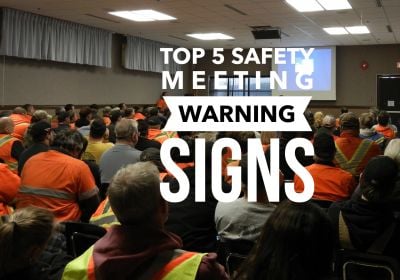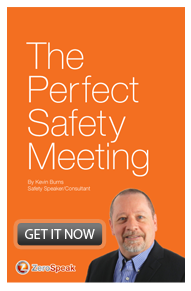Top 5 Safety Meeting Warning Signs
Could workforce disengagement levels be a contributing factor to ineffective safety meetings?
 Safety is the only department in an organization that has a legal requirement to hold meetings. No other department is legislated to meet. Meanwhile, there is no OH&S requirement to make safety meetings boring, disengaging, frustrating or ambiguous. That is done voluntarily.
Safety is the only department in an organization that has a legal requirement to hold meetings. No other department is legislated to meet. Meanwhile, there is no OH&S requirement to make safety meetings boring, disengaging, frustrating or ambiguous. That is done voluntarily.
Having attended hundreds of safety meetings in the last ten years or so, my anecdotal observations have noted:
- five percent of safety meetings could be considered highly-effective and engaging
- twenty-five percent of meetings are pointed in the right direction with some adjustment needed to make them more effective
- seventy percent of safety meetings could be considered ineffective and in need of an overhaul
Coincidentally enough, Gallup reports 70% disengagement levels across the North American workforce. Is there a correlation? Could disengagement be a contributing factor to ineffective safety meetings?
Supervisors have got to get better at engaging their crews. And safety managers have to support them by creating engaging safety meetings. But how do you know if your safety meetings are not engaging your people?
Here are five warning signs that your safety meetings are not hitting the mark in engagement:
1Attendees overwhelmingly want to know, "what time will this be over?" If the first question is about what time the meeting ends, your people are already mentally checked-out. If they’d rather be be off doing something else, then they don’t want to be attending a safety meeting. Their bodies may be physically present, but their minds are somewhere else. It will be difficult to say anything in the meeting and make it stick. You must make your people feel like their attendance and participation matters.
2Nobody brings writing materials. In other departments, notice whether meeting attendees bring something to take notes on. Of course they do. If you’re attending a meeting, you’re doing so to learn, to discuss, to develop solutions and to come to consensus. Safety meetings that masquerade as lectures and sermons don’t encourage note-taking or participation. After all, no one carries pen and paper into church do they? Provide pens and paper for everyone and then, during the meeting, occasionally say, “now write this down.” They will.
3The four basic must-know questions have not been answered. Meeting attendees want to know:
1. why they are there,
2. what they are going to learn,
3. why it is important,
4. what you expect them to do with the information.
Miss on any of these four points and attendees check-out mentally. If it’s not clear why they are there, there is no expectation that they need to remember any of the information discussed. What then, is the point of sitting through it - other than meeting attendance being mandatory (or implied). Make sure you get the meeting agenda into the hands of attendees early.
4The same one or two people do all the talking. If only one or two command the lion’s share of meeting time, then they’re not meetings. They’re lectures and sermons - which only require attendees to sit quietly and listen. That’s not terribly engaging. Meetings are supposed to create discussion and get input from everyone. Sadly, some discourage participation for fear that the meeting will go off the rails. Participation is discouraged to avoid a whine-fest of complaints. As a result, attendees leave the meeting thinking less of their workplace. Instead, introduce a recurring problem or issue that needs fixing and open the floor to suggestions. And stay focused on point.
5There is no call-to-action or clearly-defined next step. Meetings are supposed to solve problems and develop solutions. If there’s no action coming out of a meeting then you could have handed out a memo and covered the same material. Meetings are meant to spur action. What do you want your people to do differently? Point everything in your meeting at accomplishing that. Then ask them to do it - and follow it up.
 Put yourself in the shoes of the average safety-apathetic employee. Assess if your meetings spur people to want to be better? Or is the purpose of the meeting ambiguous? Do your safety meetings offer ideas and strategies to help the front-line worker? Or do your meetings only satisfy the legal requirement?
Put yourself in the shoes of the average safety-apathetic employee. Assess if your meetings spur people to want to be better? Or is the purpose of the meeting ambiguous? Do your safety meetings offer ideas and strategies to help the front-line worker? Or do your meetings only satisfy the legal requirement?
Ineffective meetings are easy to organize and take little effort. Effective meetings though, take thinking, planning and strategy. Effective safety meetings engage and excite. When you get excited about building engaging safety meetings, attendees will get excited. But don't forget, you are going to need their help to do it.
Kevin Burns is a management consultant, safety speaker and author of "The Perfect Safety Meeting" and "Running With Scissors - 10 Reasons To Invest in Safety In Slow Times." He is an expert in how to get through to people and believes that the best place to work is always the safest place to work. Kevin helps organizations integrate caring for and valuing employees through their safety programs.



